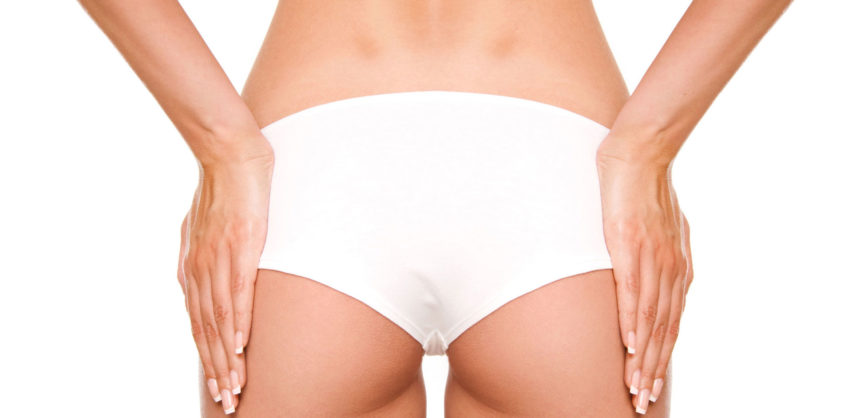What causes cellulite on buttocks? The causes of cellulite formation on the buttocks are unclear; there are several theories that have been more or less accepted by the scientific community which make it possible to have a general picture of the situation. Based on this information, it is believed that the most common causes of cellulite formation on the buttocks are:
- Genetics
- Metabolism
- Water retention
- Slowed down blood circulation
- Weight changes
- Little or no physical activity
- Incorrect nutrition
- Hormonal imbalances
- Sagging of the skin caused by ageing
Why do we need to identify the cause or causes that lead to cellulite on buttocks?
Because they can influence the severity of the blemish. As a first approach to the problem, you could straight away:
- Change lifestyle
- Take regular physical exercise
- Follow a proper diet
Cellulite is not dangerous, but even if it does not pose a health risk, it can certainly negatively affect behaviour, and therefore quality of life. Low self-esteem causes many disorders that can develop into real illnesses in susceptible individuals.
Much-hated cellulite on buttocks: What causes cellulite on buttocks?
The buttocks are among the parts most affected by cellulite and localised adipose tissue deposits.
The presence of cellulite on the buttocks appears as:
- Dull skin colour
- Cold skin, painful to the touch
- Poorly elastic skin
- Skin with “orange peel” appearance
Stagnation of fluids is one of the causes theorised behind the formation of cellulite.
Stagnation leads to:
- Formation of sclerosised collagen
- Blocking of adipocytes
- Accumulation of waste
- Poor oxygenation
- Increase in fluids
- “Orange peel” skin
- Strong inflammatory state.
Because cellulite is an inflammation of the tissue, rather than of fat.
What causes cellulite on buttocks? When to resort to surgery
To prevent cellulite, knowing the causes allows interventions with non-invasive treatments, but sometimes elimination of cellulite from the buttocks calls for surgery, which is the most extreme way to treat this blemish.
The intervention is the end point of a pathway, but before resorting to aesthetic surgery other routes should be tried. Diet and physical exercise should be the basis of work on which to build the strategy. Non-invasive interventions can be used before surgery or even in a programme that combines different treatments.
What causes cellulite on buttocks; when are we talking about adipose tissue and when are we talking about cellulite?
Fat is different from cellulite because:
- The skin is more compact
- The skin does not have an “orange peel” appearance
- It does not hurt when touched.
The function of localised adiposity in the body is of vital importance because:
- It is an energy reserve
- It accumulates in different points like the belly, hips, thighs and buttocks, as well as in the rest of the body.
Localised adiposity is an energy reserve that allows the body to perform its functions – both routine and extraordinary – properly. Greater caloric intake becomes localised reserve adiposity and is deposited.
What causes cellulite on buttocks and how to treat cellulite on buttocks
Cellulite can be eliminated by resorting to aesthetic surgical interventions, and improves with less invasive aesthetic techniques, although the results are usually temporary.
The most appropriate treatments, based on the cause:
Liposuction
Liposuction requires local anaesthesia associated with the area and only rarely general anaesthesia, while in the case of mini liposuction, local anaesthesia can be used. Mini liposuction is used for the treatment of cellulite.
The best result is obtained by combining different techniques.
The desired results will be visible over time and are not immediate, also due to the presence of diffuse edema. The more superficial cellulite may remain visible.
Aesthetic medicine
Non-invasive techniques include:
- Tissue stabilized guided subcision
- Cavitation/Ultrasound
- Radiofrequency
- Electrolipolysis
- Cryosculpture
- Laser
- Pressotherapy
- Lymphatic drainage
The results are almost immediate, but not always long-lasting, so maintenance treatments are required.
What causes cellulite on buttocks? How to reduce the impact of the causes and prevent cellulite formation on buttocks
Nutrition
Foods supply indispensable and diverse nutrients:
- Proteins: meat, dairy products, eggs and legumes.
- Carbohydrates: bread, cereals, pasta, sweets and sugar. These foods are stored as fat if consumed in excess.
- Fats: Fats (or lipids) are abundant in ice cream with cream and chocolate, in plant oils (from olives, soy, corn, etc.), in lard, in margarine.
- Vitamins and Minerals: vegetables and fruit.
To prevent the formation of cellulite and therefore attenuate the causes, some foods should be avoided, such as:
- Salt in excess
- Foods that are very rich in fats, or overly processed
- Alcoholic drinks
- Sweet foods and sugar
- Long periods without food
- Eating too much at dinner
What should be favoured:
- Raw vegetables
- Regular meals
- Eating more at breakfast and lunch
- Drinking plenty of water
- Wholemeal foods
What causes cellulite on buttocks, understanding the causes of cellulite helps us to better orient ourselves in the choice of treatment, but a healthy and balanced diet, with physical exercise, also helps reduce overweightness, which worsens cellulite and is a health risk.


